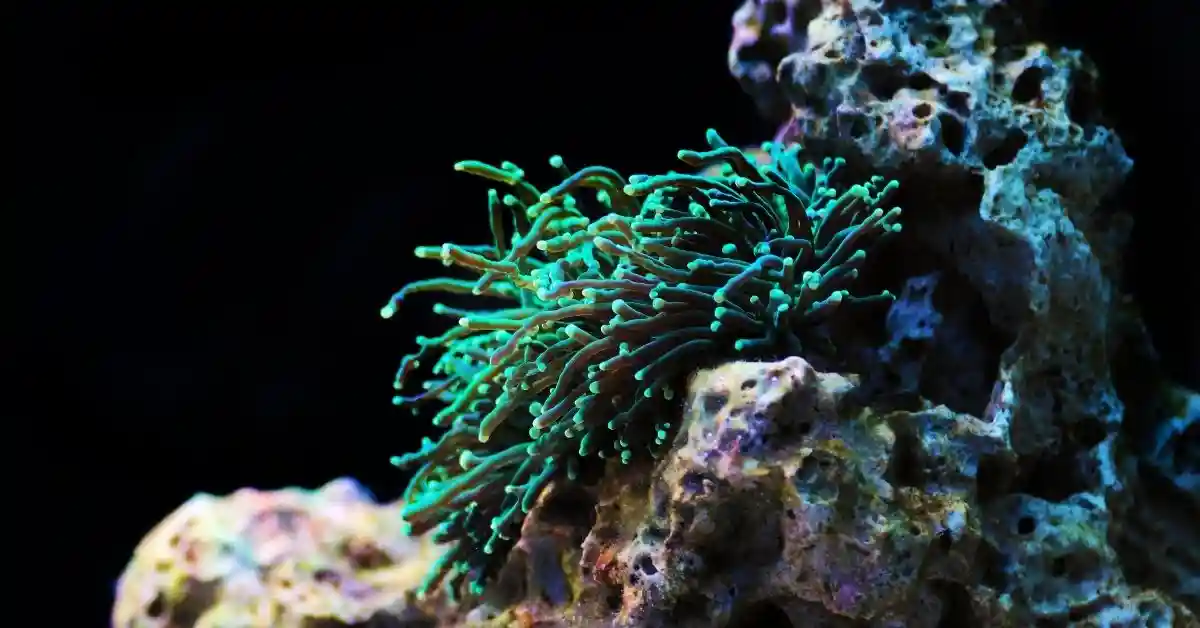Have you had a torch coral inside your aquarium? since it’s not opening, are you afraid you’re handling it wrongfully? Don’t worry about it too much.
We’ve gathered all the information you’ll need to open the torch coral.
Why is the torch coral not opening?
Torch coral is extremely sensitive to sunlight and water movement. Trying to move them around every matter of days since they won’t open up isn’t the greatest way to handle this condition.
Each head will emerge for a brief duration before returning.
Let’s go down and talk about why torch coral is not opening.
Which one is torch coral?
The Torch coral, scientifically known as Euphyllia glabrescens, is a large polyp solid (LPS) coral native to Indo-Pacific coasts.
Long, flowing, fleshy polyps grow from a calcified rocky foundation on the torch coral.
These corals resemble a torch in moderate water flow, thus their popular name.
Care of Torch Corals
Torches are said to live in various water conditions, including turbid (murky) waters and clear waters with a blazingly crisp light.
This indicates a certain amount of flexibility and easiness, which is most likely why these corals are excellent for beginners.
The torch coral does not have very complex management requirements in a marine aquarium.
Those who require standard marine aquarium water conditions such as a temperature of roughly 78F (25.5C), a specific gravity of around 1.025, a pH of around 8.2, and a calcium content of around 400ppm.
A torch coral, like other big polyp stony corals, benefits from moderate water movement.
If the water circulation is too rapid, the polyps remain retracted and under-inflated because huge moving polyps are prone to splitting and tearing.
Feeding of Torch Corals
The torch coral is a photosynthetic organism. It has a symbiotic association with zooxanthellae (single-cell photosynthetic organisms) that dwell within its tissues.
Conversion of sunlight into sugar by them. In exchange for a home inside the coral, the zooxanthellae share their harvest and feed it.
As a result, it is feasible to retain torch coral without giving additional nourishment.
Most of the corals, on the other hand, are animals, and animals are supposed to eat.
While feeding them is technically not required, the fact that they are physiologically capable of consuming very large, meaty meals implies that feeding them accurate cuisine is greatly advised.
Placement of Torch Coral
A torch coral should be placed in an area with moderate water flow and moderate-intensity illumination.
Like Goldilocks, you don’t want the lighting or the water flow to be too hot or too cold.
Water Flow
Unless next to a powerhead or light source, the margins or corners of your tank are likely to have lower flow and light levels.
The sections right in front of your powerheads or gyre pumps, on the other hand, have the maximum flow.
Whenever the polyps are completely stretched and gently swaying, as though in the wind, medium flow is attained.
Light Intensity
The strongest light intensity is found in the higher parts of live rock high in the tank and the areas most centrally positioned under your LEDs.
Save such locations for the light-hungriest corals, notably SPS and corals with the brightest colors, assuming you have high-quality reef LEDs, metal halides, or T5s.
Even though this is a general rule, the middle-to-lower ends of the tank are the greatest locations for your torches.
And they’re still in relatively bright sunlight, but not just beneath the brightest area.
Why is Your Torch Coral Not Opening?
If your torch coral polyps are not opening, you must troubleshoot to determine the problem accurately.
The first step is to check to see if anything has changed.
- Were your powerheads pointing in the same direction and producing the same flow?
- Were your water parameters in perfect condition?
The only way to figure out what has to be fixed is to test the water parameters and be openly and entirely honest about the results.
I’ll admit that there are times when I get behind on tank maintenance, and the water quality suffers.
An increase in water flow, illumination, pH, or salinity might all be to blame.
You must also ensure that nothing bothers the coral polyps, such as Aiptasia anemones or starving fish.
Repair any water parameter concerns you uncover, and make sure they’re getting adequate flow and sunlight.
Problems to Expect When Keeping Torch Corals
One of the common mistakes I’ve seen new aquarists make is forgetting to account for the mineral requirements of these corals.
Torch corals will not grow their coral skeleton if inadequate calcium is in your aquarium water.
You must avoid lifting a torch coral out of the water if possible.
The polyps might be torn. Torn polyps are susceptible to infection, which is accompanied by necrosis which is a complete deterioration of tissue.
FAQs
Question: Will clownfish be able to host a torch coral?
Answer: Torch corals will support clownfish, but the clownfish will certainly destroy it with their “nuzzling.” When clownfish begin interacting with the coral, they will never fully grow.
Question: Is it possible for torch coral to sting fish?
Answer: They do not hurt your fish, but I would recommend using gloves when handling them. Stung by torches is quite painful and can cause a hole in your flesh!
Question: Torch corals, are they toxic?
Answer: LPS corals feature jellyfish-like nematocysts, little harpoon-like barb cells on tentacle ends that shoot mild poisons into bothersome neighbors.
Question: Do torch corals suffocate at night?
Answer: It’s typical for your torch or any coral to shut up some when the lights go out, as others have stated.
Final Words
That’s all you need to know if your torch coral does not open. If you want to learn more about it or other corals, we have detailed articles on them.


